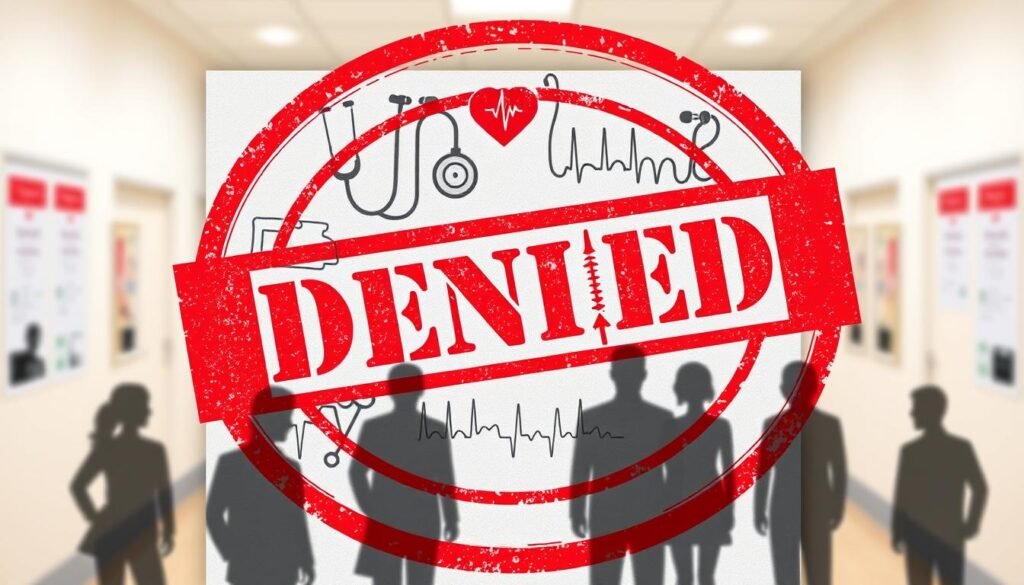As 2024 ends, millions of Americans must choose their 2025 health insurance. They can pick from employer plans, the ACA marketplace, or Medicare1. The open enrollment period is from November 1, 2024, to January 16, 2025. You must decide by December 15th for coverage on January 1, 20251.
This is a critical time for making choices that affect your finances next year. Regina Ihrke from WTW advises taking time to understand what’s offered. Most people can only shop for health insurance once a year, unless they have a qualifying event. The choices for 2025 are vital because healthcare costs are rising fast. This could mean higher premiums and out-of-pocket costs for you.
Key Takeaways
- The federal Open Enrollment Period for 2025 health coverage runs from November 1, 2024, to January 16, 2025, with a December 15th deadline for coverage starting January 1, 20251.
- Several states, including California, Colorado, and Washington D.C., have announced permanent extended open enrollment periods1.
- Coverage options during Open Enrollment include employer-sponsored plans and ACA (Affordable Care Act) plans1.
- Health insurance plans offer various tiers of coverage, such as Bronze, Silver, Gold, and Platinum, with different cost-sharing structures1.
- Flexible Spending Accounts (FSAs) and Health Savings Accounts (HSAs) can provide tax advantages for managing healthcare costs1.
Understanding Major Medical Policies
Major medical policies offer a wide range of medical services. They include inpatient and outpatient care, preventive services, and prescription drug coverage2. These policies help protect against high medical costs, making them a top choice for many.
What Are Major Medical Policies?
Major medical policies, also known as full health insurance, cover many healthcare services3. They meet the Affordable Care Act (ACA) standards. This ensures they offer the essential health benefits required by law3.
Key Features of Major Medical Policies
Major medical policies have several important features:
- Coverage for inpatient and outpatient care, including hospital stays2, surgical procedures, and doctor visits
- Preventive services, like annual check-ups, cancer screenings, and immunizations, often at no extra cost2
- Prescription drug coverage, including both generic and brand-name medications2
- Mental health and addiction services3
- Deductibles, copayments, and out-of-pocket maximums to manage healthcare costs2
These policies aim to provide full coverage. They help protect people from the financial shock of unexpected medical bills3.
“Major medical insurance plans are accessible even for individuals with pre-existing conditions.”3
Understanding the key features and coverage of major medical policies is vital. This knowledge is important during the open enrollment period or when seeking coverage due to a qualifying life event3.
Types of Coverage Offered
Major medical policies offer a wide range of coverage for your health needs. They cover inpatient and outpatient care, preventive services, and prescription drugs. These policies aim to protect you from unexpected healthcare costs4.
Inpatient and Outpatient Care
Inpatient care covers hospital costs like room and board, surgeries, and treatments that require a stay. Outpatient care, on the other hand, includes doctor visits, tests, and treatments that don’t need a hospital stay5.
Preventive Services and Screenings
Preventive care is key in major medical policies. It helps keep you healthy and catches health issues early. These policies often cover annual check-ups, immunizations, and screenings like mammograms and cancer tests4.
Prescription Drug Coverage
Many policies also cover prescription drugs, lowering your costs for medications. Coverage levels vary, with different tiers for generic, brand-name, and specialty drugs45.
It’s vital to check each plan’s details to see what’s covered. This helps you pick the best plan for your health and budget.

“Preventive care is the foundation of a healthy lifestyle, and major medical policies ensure that you have access to the screenings and services you need to stay on top of your health.”
Eligibility and Enrollment
Understanding health insurance can be tough. But knowing how to get major medical policies is key. You might get coverage through work or the Affordable Care Act (ACA) marketplace. The rules and when you can sign up differ a lot.
Who Can Purchase Major Medical Policies?
Who can buy major medical policies depends on where you get it from. Work plans are for full-time employees and their families6. But, if you can’t get affordable work coverage, you can look at ACA plans.
Open Enrollment Periods and Timing
When you can sign up for a policy is very important. The federal Open Enrollment for 2025 starts on November 1, 2024, and ends on January 16, 20257. Some states have their own times, so knowing these dates is key to not losing coverage.

Also, big life events like getting married or having a baby can open a Special Enrollment Period (SEP). This lets you sign up outside the usual times7. Knowing these rules helps keep your health insurance going without breaks.
“Staying on top of open enrollment periods and understanding your eligibility can make a significant difference in accessing the health insurance coverage you need.”
How Premiums Are Determined
Major medical policies have premiums influenced by several factors. Your age, location, tobacco use, and coverage level all play a part in the cost8. Plans with lower premiums often have higher deductibles and copays. It’s key to look at the yearly costs, not just the monthly8.
Factors Influencing Premium Costs
Several factors can change your health insurance premiums. Your age is a big factor, with older people paying more8. Smoking can also raise your costs, with smokers paying up to 50% more than non-smokers8. Your location also matters, with rural areas often having higher premiums due to less competition8.
Understanding Deductibles and Copayments
It’s important to know how premiums, deductibles, and copays work together. Plans are grouped into metal tiers (Bronze, Silver, Gold, Platinum) based on premium and coverage levels8. Plans with lower premiums usually have higher deductibles and copays. But, plans with higher premiums often have lower out-of-pocket costs8.
Employer-sponsored plans can also offer cost benefits, as employers often pay a big part of the premiums8.
By thinking about your healthcare needs and the trade-offs between premiums, deductibles, and copays, you can find a plan that fits your budget and meets your coverage needs. Explore the total costs of health insurance to make a smart choice.
“Choosing a health insurance plan that aligns with your specific healthcare needs can help manage costs effectively.”
Benefits of Major Medical Policies
Major medical insurance covers a wide range of medical needs. This includes routine checkups and complex treatments. These plans protect against high medical costs with out-of-pocket maximums. This limits what you must pay in a year3.
These policies also cover ten essential health benefits. This includes hospitalization, outpatient procedures, and preventive care. They also cover prescription medications, mental health services, and more3. Unlike short-term plans, major medical policies cover emergency care and routine expenses like doctor visits and lab tests9.
Major medical insurance is also available to those with pre-existing conditions. The ACA rules prevent insurers from denying coverage based on health history. This makes these plans more inclusive for those with ongoing medical needs3.
Also, major medical policies can qualify for subsidies under the ACA. This makes them more affordable, during open enrollment or special enrollment periods3. But, these plans can be more complex. They have longer enrollment periods and may have higher premium costs9.

Overall, major medical policies offer great coverage and financial protection. They are a valuable choice for reliable health insurance10. By understanding their benefits and limitations, individuals can make informed decisions. This ensures they have the coverage they need9.
Common Exclusions in Major Medical Policies
Major medical policies cover a lot, but they have some limits. Knowing these can help you pick the right plan for you11.
What Is Typically Not Covered?
Pre-existing conditions are often not covered. This includes things like asthma, diabetes, and back pain11. Some areas even limit coverage for unknown conditions11.
Other things not covered are cosmetic surgery, experimental treatments, and high-risk sports11. Substance abuse, self-inflicted injuries, and mental health care were once excluded, but this is changing11.
Understanding Pre-existing Conditions
The Affordable Care Act has changed how pre-existing conditions are handled. Most plans now cover them, but there might be limits or waiting times11. Always check your policy for any specific rules12.
Knowing what’s not covered helps you choose the right policy. This way, you can meet your health needs and stay within your budget1112.

“Understanding the exclusions in your major medical policy is key to getting the coverage you need.”
Navigating the Claims Process
Understanding your major medical policy means knowing how to handle claims. Most in-network providers take care of filing claims for you13. But, if you see an out-of-network doctor, you’ll need to do it yourself.
Steps to File a Claim
To file a claim, you’ll need to give some basic information13. This includes the date of service and the type of care. Many insurance companies have online tools to make this easier.
It’s key to keep good records of your medical care and talks with your insurance. This helps a lot when filing claims.
What to Do If Your Claim Is Denied
If your claim is denied, don’t worry. You can appeal the decision14. First, look at the Explanation of Benefits (EOB) to see why it was denied. It might be because of coverage issues or errors.
Then, start the appeals process as your insurance plan suggests. It’s a bit of work, but it’s worth it to get the coverage you need.
Dealing with claims can be tough, but being organized helps. Your insurance company is there to help, so don’t be afraid to ask for help15.
“Proper claims processing is key to avoid denials, delays, and patient complaints.”15
State-Specific Regulations
The health insurance scene in the U.S. is shaped by state laws. These laws affect what coverage people can get16. The Affordable Care Act (ACA) of 2010 brought new rules, making the system change often16.
How State Laws Shape Coverage Options
Even though the feds set basic health insurance standards, states can add more rules17. Places like California, Colorado, and Washington D.C. have made it easier to get health insurance by extending open enrollment periods for 202516.
State insurance officials also enforce laws to protect consumers, mainly in the individual market18. Knowing your state’s rules is key to picking the right health insurance.
Navigating the State-Based Marketplace
Many states have their own health insurance markets. These markets offer plans that might not be found on the federal site. State-based exchanges have their own rules and times for signing up, so it’s important to check your state’s specifics.
Whether you’re looking for individual or group coverage, knowing your state’s rules helps you choose wisely. This ensures you get the best health insurance for you1618.
“The health insurance landscape is constantly evolving, and staying up-to-date on state-specific regulations is key to finding the right plan for your needs.”
Tips for Choosing the Right Major Medical Policy
Choosing a major medical policy requires careful thought. Start by thinking about your health needs for the next year. This includes any surgeries, regular doctor visits, and medications you’ll need19. Knowing this helps you pick a plan that fits your health and wallet.
Key Questions to Ask Before You Buy
When looking at different policies, ask important questions. Find out the monthly cost and the annual deductible19. Also, check if your doctors and hospitals are in the plan’s network19. Make sure the plan covers your prescription drugs and if they’re available through the plan’s pharmacies19.
Comparing Different Plans and Providers
To pick the right policy, compare plans from different providers. Use online tools and talk to unbiased experts like insurance brokers or navigators20. Look at the provider network, drug coverage, and costs to find the best match for your health and money19. Keep in mind, higher premiums might mean lower costs for you, while lower premiums could mean higher costs19.
FAQ
What are major medical policies?
What key features should I look for in a major medical policy?
Who can purchase major medical policies?
When can I enroll in a major medical policy?
What factors influence the cost of major medical premiums?
What are the benefits of having a major medical policy?
What are some common exclusions in major medical policies?
How do I file a claim for a major medical policy?
How do state regulations impact major medical policies?
What should I consider when choosing a major medical policy?
Source Links
- Open Enrollment Guide 2025 | eHealth – https://www.ehealthinsurance.com/resources/affordable-care-act/everything-to-know-about-the-annual-open-enrollment-period
- What is Major Medical Insurance? – https://www.valuepenguin.com/what-major-medical-health-insurance
- What Is Major Medical Insurance? | eHealth – https://www.ehealthinsurance.com/resources/affordable-care-act/what-is-major-medical-insurance
- Health plan categories: Bronze, Silver, Gold & Platinum – https://www.healthcare.gov/choose-a-plan/plans-categories/
- Plan Types – https://www.opm.gov/healthcare-insurance/healthcare/plan-information/plan-types/
- Insurance Overview: Major Medical, Short-Term, Fixed Indemnity – Center Forward – https://center-forward.org/basic/insurance-overview-major-medical-short-term-fixed-indemnity/
- Major Medical Insurance: The Basics | GoHealth – https://www.gohealth.com/health-insurance/major-medical-insurance/
- Major Medical Insurance Costs | eHealth – https://www.ehealthinsurance.com/resources/affordable-care-act/major-medical-health-insurance-plans
- What Should You Know About Major Medical Insurance? – https://www.healthmarkets.com/resources/health-insurance/what-is-major-medical/
- Understanding Short-Term Limited Duration Health Insurance | KFF – https://www.kff.org/affordable-care-act/issue-brief/understanding-short-term-limited-duration-health-insurance/
- 7 Common Exclusions in Your Health Insurance Policy | Alea – https://alea.care/health-insurance/how-exclusions-impact-your-health-insurance
- 10 Most Common Exclusions In Health Insurance – Onsurity – https://www.onsurity.com/blog/exclusions-in-health-insurance/
- Medical claims 101: What you need to know – https://www.definitivehc.com/blog/medical-claims-101-what-you-need-to-know
- Health Insurance Claims & How They Work | eHealth – https://www.ehealthinsurance.com/resources/individual-and-family/what-is-a-health-insurance-claim
- Master Medical Claim Processing | Unlock Efficiency and Accuracy – https://www.medicaladvantage.com/blog/guide-to-healthcare-claims-processing/
- The Regulation of Private Health Insurance | KFF – https://www.kff.org/health-policy-101-the-regulation-of-private-health-insurance/
- 45 CFR Part 144 — Requirements Relating to Health Insurance Coverage – https://www.ecfr.gov/current/title-45/subtitle-A/subchapter-B/part-144
- Health Insurance – https://content.naic.org/consumer/health-insurance.htm
- How to Choose Health Insurance: Your Step-by-Step Guide – NerdWallet – https://www.nerdwallet.com/article/health/choose-health-insurance
- 6 tips to help you pick the right health insurance plan – https://www.npr.org/sections/health-shots/2021/11/01/1050878727/6-tips-to-help-you-pick-the-right-health-insurance-plan
